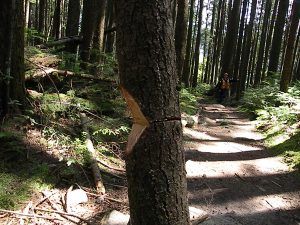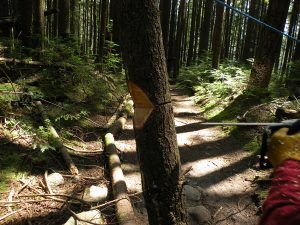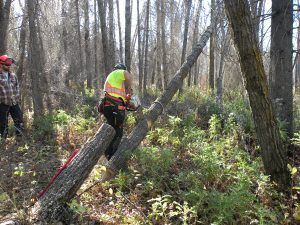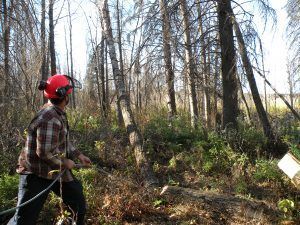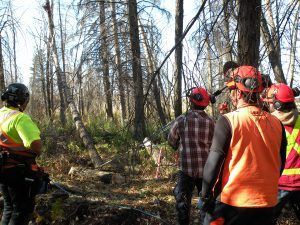Controlled Hinge Release – releasing lodged or hung up trees.
In my last article I shared a technique for safely releasing lodged or hung up trees. I am going to expand on this concept in this article.
One disadvantage of the mis-match cut is that in some cases, the vertical wood fibre lamination may release before the saw operator is at a safe distance away. It is a rare occurrence, but it can happen and is an example of why alternative techniques are always good to have in the mental toolbox.
The controlled hinge release is another technique for releasing hung or snagged trees that can offer some additional control when cutting these types of trees.
The controlled release hinge technique is employs the use of a notch and also requires the hinge to be established using a bore cut. The notch and hinge are set before the final back cut is made and optimizes safety by using a mismatched back cut and a pull line to release the tree when the operator is ready and clear of the danger zone.
An open face notch is cut in the opposite side of where the pull line is installed. This way when the tree is pulled, the notch closes and the tree hinges towards the pull line. The placement of the notch should not only consider the pull line direction but also the side that best facilitates the dislodging of the snag or hung tree.
The bore cut establishes the hinge which should be made thinner than normal when dealing with a standing tree. Instead of the standard 10% to 7% of diameter, a maximum of 5% to 3% should be used. This is due to the lack of bending moment that exists in hung or snagged tree scenarios. A limitation of this method is that it is best suited for large enough diameter tree where there is enough wood behind the hinge to allow for the bore cut to be made and in situations where the butt of the tree is not attached to the roots or dug into the ground.
First attach a pull line to the tree and install any mechanical advantage needed to pull the tree. Once the notch and hinge are cut, you will have the small portion of wood left uncut at the back of the tree – commonly called the ‘strap’. The final step is to place a by-pass or mis-match cut just below the bore cut and cut far enough so that this kerf passes the kerf above, creating a mis-matched strap. This will hold or control the release of the tree until a load is applied to the pull line.
The strap releases and the tree will fold or ’walk’ in the direction of the pull line when the tree is pulled. Often this action is enough to dislodge the hung tree or snag. If it does not, the line is moved up and the technique is repeated. The repeated cuts move the snag or hung tree in a lateral direction, encouraging it to dislodge and keeping the snag from becoming more vertical where it is likely to fall unpredictably when it dislodges. The controlled release hinge maximizes cutter control and safety.
An article is no substitute for hands on training and this article is intended to stimulate thought. I trust my description along with the photo’s can help you to understand this very effective technique for freeing hung or snagged trees.
Too often a variation of this technique is used with a conventional back-cut, where the notch is cut in the upper side of the snag and the hinge is formed with the cutter standing right beside the tree and a very quick and abrupt jump is made in an attempt to escape as the tree releases and hinges. Control is not part of this technique and can result in the cutter being struck or pinned by the butt of the tree. This technique also moves the tree closer to the snagged or hung obstacle, causing the tree after frequent attempts to become more and more vertical resulting in a very large and dangerous drop zone.
It is a known fact that 90% of all tree cutting accidents occur within 5 feet of where the final cut is made, within 15 seconds of the tree beginning to fall or hinge. This is called the 5-15-90 rule. It stands to reason that if the tree can be released at a distance greater than five feet and before falling or hinging action begins that the likelihood of being injured is reduced by 90%. It is with this thought in mind that the controlled release hinge is utilized.
In my next article I plan to share another technique which is well suited for scenarios where an uprooted tree is hung or snagged, or where the butt of a snagged or hung tree is dug deep into the ground.
Dwayne Neustaeter

